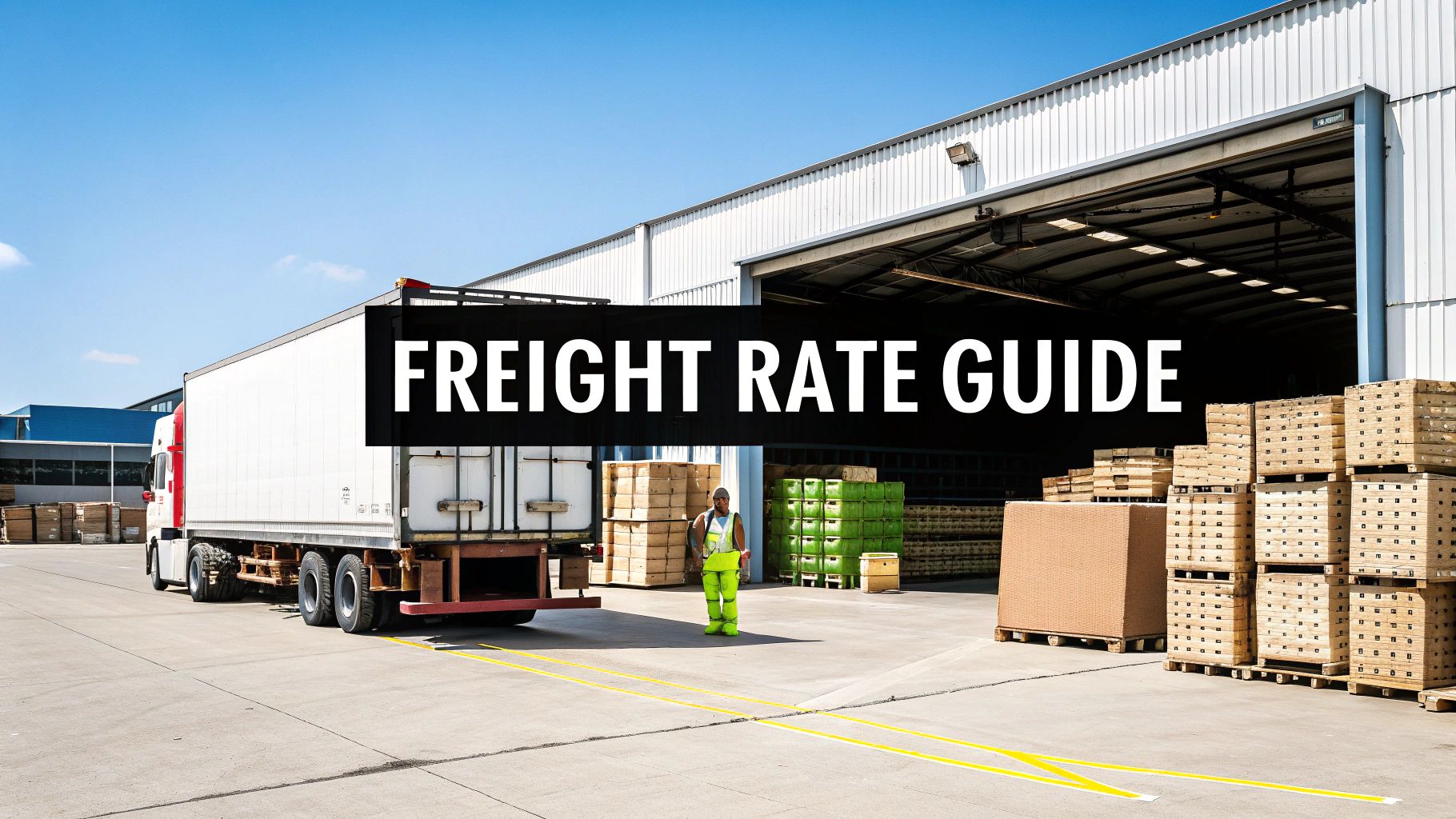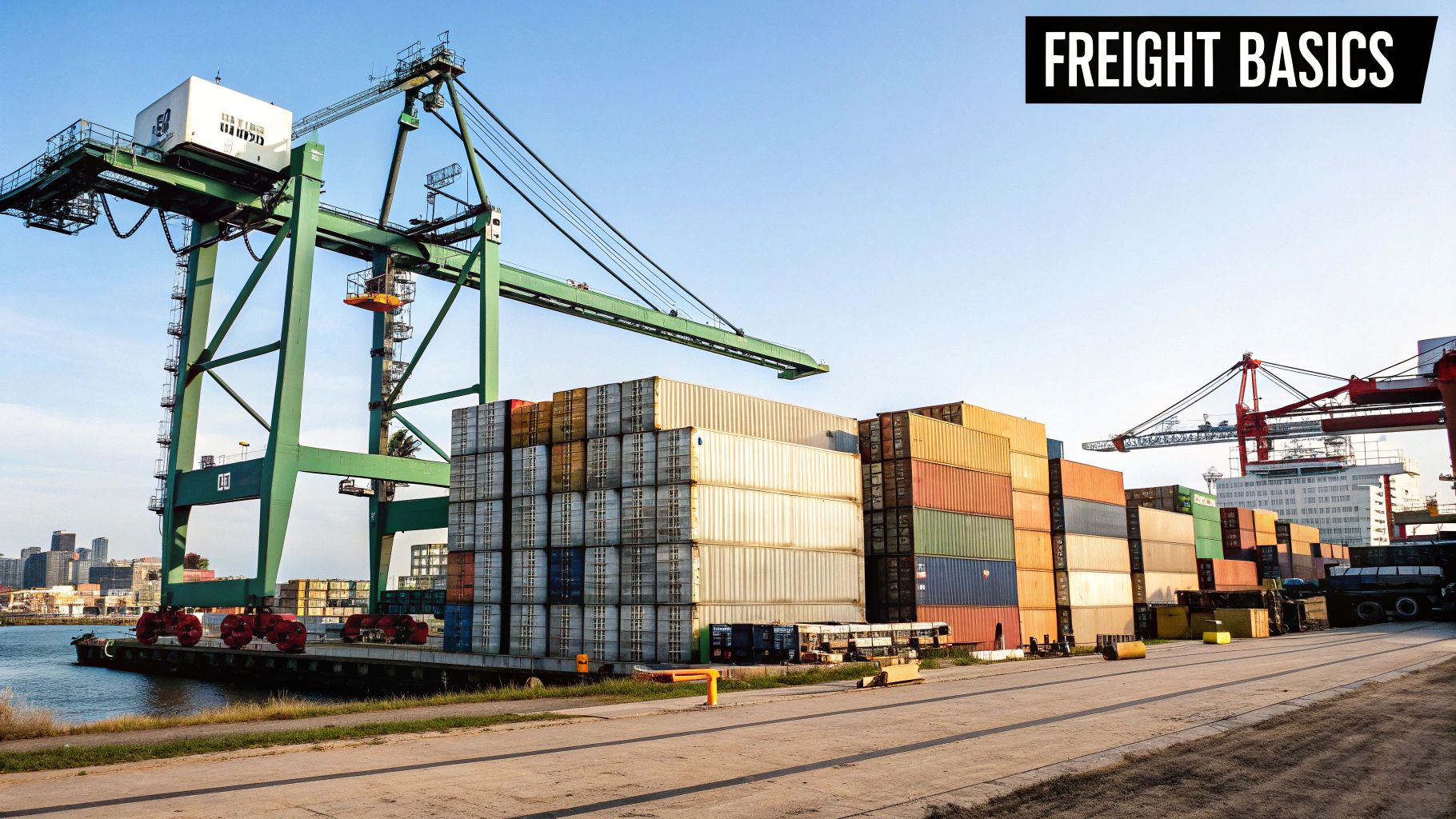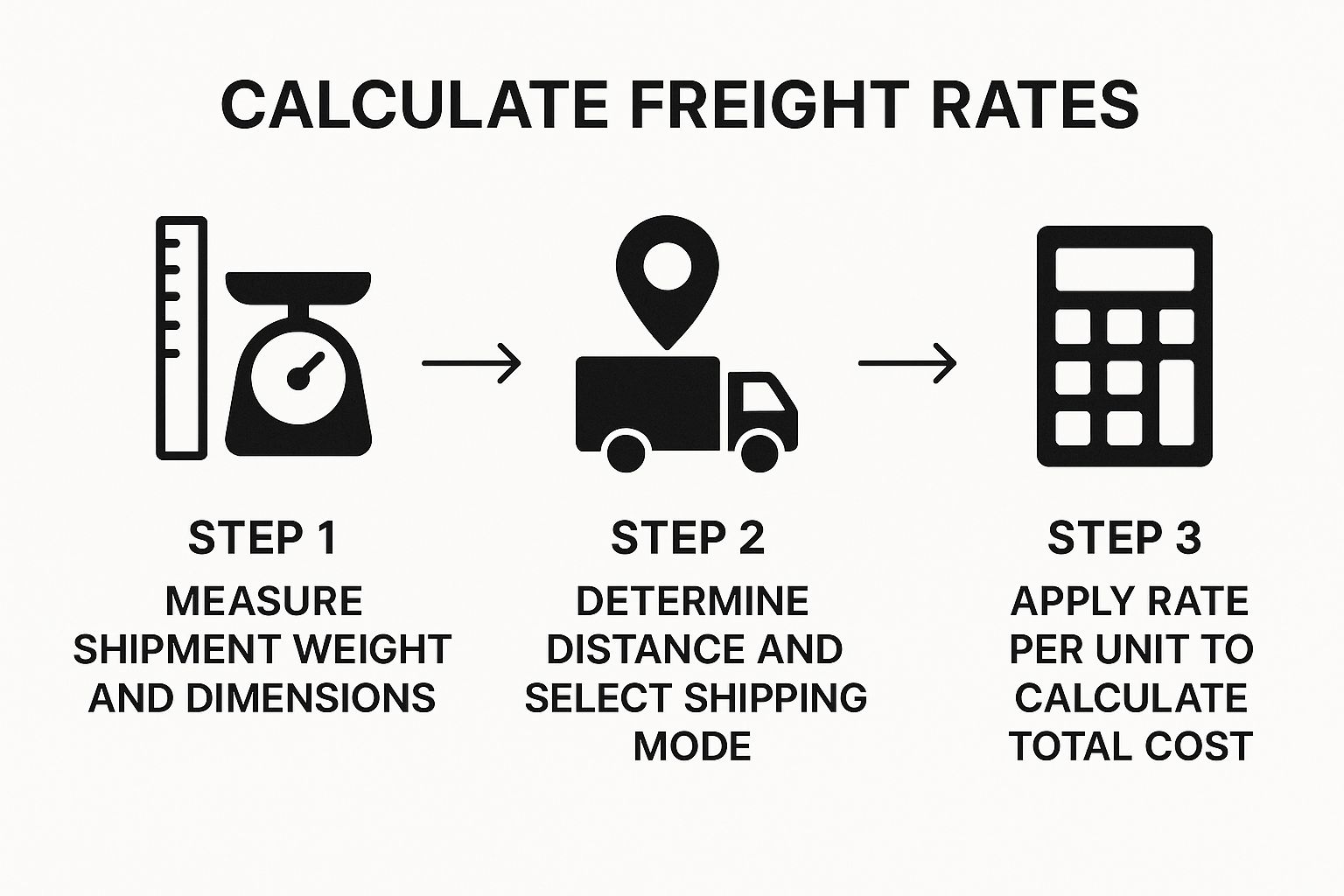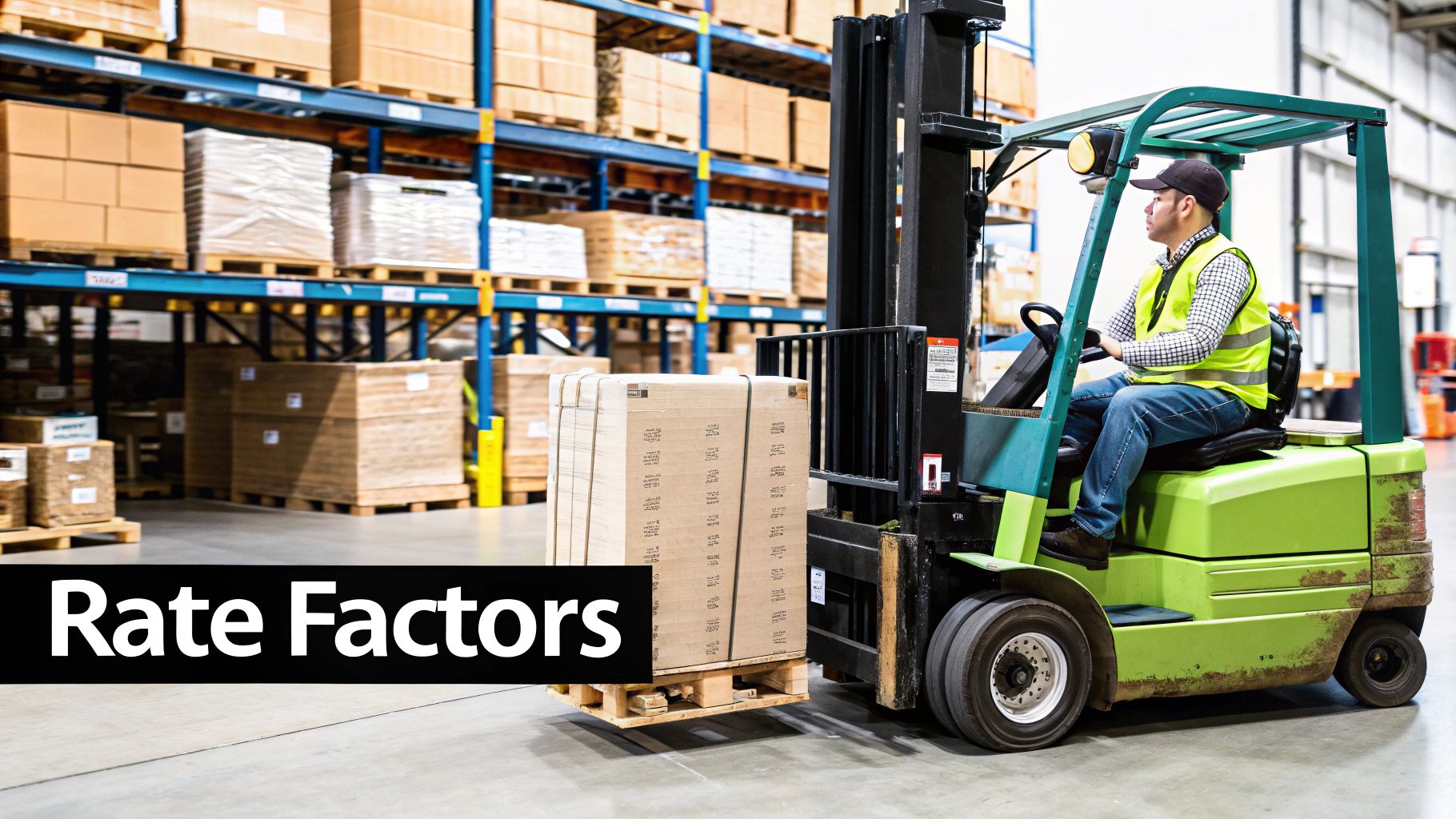Learn how to calculate freight rate with our complete guide. Discover the key factors for LTL and FTL shipping and get tips to lower your costs.

Figuring out a freight rate isn't just about plugging numbers into a calculator. It’s a mix of several key factors, and understanding how they work together is the first step to getting a price you can trust. For a full truckload (FTL), it often boils down to a per-mile rate driven by market demand. But for less-than-truckload (LTL), things get more granular, with density and freight class playing a huge role.

Before you can even think about getting an accurate quote, you have to know what ingredients make up the final price. A freight rate isn't just a random number; it's a careful calculation based on specific details about your shipment.
Getting these details right from the very beginning is the secret to avoiding those nasty surprise fees and finding the best possible price. I've seen it time and again: guessing on weight or dimensions is a surefire way to blow your budget. Precision is your best friend here.
No matter what you're shipping, a few universal variables form the foundation of your rate. These are the non-negotiables that every carrier starts with, whether you're sending one small pallet or filling an entire truck.
When it comes to trucking, the rate calculation is a critical part of the supply chain. Carriers often use mileage-based pricing that can range anywhere from $1.50 to over $4.00 per mile, heavily influenced by the specific load, lane, and current market conditions. For a deeper dive into this, you can learn more about how carriers determine these charges on planimatik.com.
This is where things get a little more complex, especially for LTL shipments. Since your cargo is sharing truck space with other shippers, carriers need a standardized way to price everything fairly. The most important piece of that puzzle is freight density.
Density is just a measurement of how much space your shipment occupies relative to its weight.
Think of it this way. You have two pallets, both weighing the same:
The pillows take up way more room on the truck, even though they have the same weight. That makes them less efficient for the carrier to transport, so they get assigned a higher freight class, which ultimately means a higher shipping cost.
Nailing these calculations isn't just about getting a quote; it's a fundamental part of good logistics planning. When you understand these core components, you gain the power to control your costs and find the smartest shipping solutions for your business.
When you dip your toes into the world of Less-Than-Truckload (LTL) shipping, you'll quickly find that the pricing game is a whole different beast. It's not just about distance and weight. The entire system revolves around something called the National Motor Freight Classification (NMFC).
Think of the NMFC as a giant sorting hat for everything that can be shipped. It categorizes all goods into one of 18 freight classes, from a low and cheap Class 50 (think steel beams—dense, durable, and easy to stack) to a high and expensive Class 500 (ping pong balls—they take up tons of space but weigh almost nothing).
This system is how carriers keep things fair when multiple shippers are sharing space on the same truck. A pallet of heavy engine parts and a pallet of fragile, bulky lampshades might take up the same floor space, but they are worlds apart in terms of how they're handled and priced. Getting the class right is the first—and most important—step to getting an accurate LTL quote.
While most people zero in on density, it's not the only piece of the puzzle. The NMFC actually looks at four distinct characteristics to assign a freight class, giving carriers a complete picture of what it takes to move your stuff.
This infographic breaks down the initial steps you'll take to get your freight rate calculation underway.

As you can see, nailing these measurements from the start is what sets you up for an accurate quote. It's the foundation for figuring out your best shipping mode and what the final cost will be.
Since density is the main driver of your freight class, you absolutely have to know how to calculate it. I've seen it time and time again—getting this calculation wrong is the fastest way to get slapped with a painful and expensive "re-class" fee from the carrier.
Let's walk through a real-world example. Say you're shipping a crate with the following specs:
First, you need to find the volume in cubic feet. Convert the inches to feet (4 ft x 3.33 ft x 3 ft). Now, multiply them together:
4 ft x 3.33 ft x 3 ft = 39.96 cubic feet
Next, to find the density, you just divide the weight by the volume:
500 lbs / 39.96 cu ft = 12.51 pounds per cubic foot (PCF)
With a density of 12.51 PCF, you'd look at an NMFC density guide. This particular shipment would most likely fall into Class 92.5.
It’s important to remember that estimating total freight cost is a multi-step process. Carriers also consider dimensional weight, often billing for whichever is greater between the actual weight and the calculated dimensional weight, to ensure all transport costs are covered. You can discover more insights about these freight cost estimates on matrackinc.com.
Trust me on this: getting your freight class correct is non-negotiable. If you just guess or get it wrong, the carrier will absolutely catch it. They re-weigh and re-measure everything at their terminal, and you'll be hit with an adjusted bill that's always higher, plus a penalty fee for the trouble.
For a deeper dive into this, you can check out our guide on using an LTL freight quote calculator.

After navigating the complex world of LTL calculations, Full Truckload (FTL) pricing can feel like a breath of fresh air. It’s much more straightforward. When you’re booking an entire truck, you can forget about freight class and density. The conversation almost always boils down to one simple metric: the rate per mile.
But don’t let that simplicity fool you. This rate is a moving target, constantly shifting with the powerful currents of the market. Getting a handle on these dynamics is the real secret to predicting your FTL costs and securing a fair price.
The single biggest factor that will influence your per-mile rate is the specific route your freight is taking. We call this the shipping lane. A 500-mile journey from a major hub like Chicago to a distribution center in Columbus, Ohio, will have a wildly different price tag than a 500-mile trip from Columbus to a small town deep in rural West Virginia.
So, why the huge difference? It's classic supply and demand.
Carriers have to price this imbalance into your quote. They’re always thinking about the risk of "empty miles" after they drop off your shipment.
Another cost that gets quietly baked into your FTL quote is deadhead—those are the miles a driver travels empty just to get to your pickup location. If the closest available truck is 100 miles away from your dock, the carrier has to account for that fuel and drive time.
That 100-mile empty trip gets factored right into your total rate. A carrier will often bump up their per-mile charge on your load to cover the unpaid travel it takes to even start the job.
This is a pro tip: if you can offer a little flexibility on your pickup date, you can often save a lot of money. Giving your logistics partner an extra day or two gives them time to find a carrier who is already close by, which minimizes deadhead and brings your overall cost down. If you want to crunch the numbers yourself, our guide on a trucking costs per mile calculator is a great resource.
Beyond the specific route, the broader market is always in flux, pushing rates up and down. To really understand FTL pricing, you have to keep an eye on these outside pressures.
This is where market indices come in handy. They gather millions of data points from carriers and shippers to give you a benchmark for what’s happening. For instance, you can get more insights on how these market indices work on freightos.com.
The base rate on your freight quote? Think of it as just the starting line. If you really want to get a handle on your shipping costs, you have to account for the extra charges that cover anything beyond a simple dock-to-dock move.
These are called surcharges and accessorial fees, and trust me, they can pack a punch on your final bill if you're not paying attention. It's kind of like booking a flight—the ticket price is one thing, but then you have fees for checked bags, seat selection, and so on. In shipping, needing a special truck or delivering to a tricky location are those "extras" that will show up on the invoice. Knowing what they are ahead of time is the secret to accurate budgeting.
One charge you'll see on nearly every LTL and FTL invoice is the fuel surcharge. This isn't a fixed fee carriers tack on for fun; it's a variable charge they use to shield themselves from the rollercoaster of diesel prices.
This surcharge is pegged to the national average fuel prices published by agencies like the U.S. Energy Information Administration (EIA). Because carriers often update their fuel surcharge tables every single week, the percentage added to your base rate can literally change from Monday to Friday. You can't get around it, but knowing it's a dynamic cost helps explain why the exact same shipment might have a slightly different price tag depending on when you book it.
A sudden spike in global oil prices can cause the fuel surcharge to jump, directly hitting your bottom line. It's a classic example of how big market forces trickle down and show up on your freight bill.
Beyond fuel, there's a whole menu of accessorial fees that cover specific, non-standard services. These charges basically compensate the carrier for doing any work that isn't just a straightforward pickup and drop-off between two loading docks.
Being upfront about your shipment's needs when you request a quote is the single best way to make sure these costs are included from the start, not as a surprise later.
Before we dive into the most common fees, it helps to see them laid out. These are the charges that pop up most often, so it pays to get familiar with them.
As you can see, these fees cover real work and time for the carrier. Now let's look at a few of the most frequent ones you'll run into.
For a deeper dive on one of the most essential accessorials, check out our guide on what is liftgate service.
The best way to manage these costs is to see them coming. Before you even request a quote, run through a quick mental checklist for both the origin and destination.
Does the building have a loading dock? Is it a business in a commercial park? Is your freight properly palletized and ready for the driver?
Answering these questions honestly at the start ensures your quote is accurate. Trying to "forget" to mention you need a liftgate won't save you a dime—the carrier will just add the fee to your final bill, sometimes with a penalty charge on top. In freight shipping, transparency always pays off.
Knowing how freight rates are calculated is one thing, but actually influencing those calculations in your favor is where the real savings kick in. Once you understand which levers to pull, you can stop treating shipping as just another cost center and start turning it into a competitive advantage.
Let's get past the theory. Here are some practical, road-tested strategies that smart shippers use every single day to cut down their freight spend. These aren't complicated secrets, just smart adjustments to how you plan and book your shipments.
One of the most powerful moves you can make is to simply think bigger. If you find yourself sending multiple LTL shipments to the same general area every week, you're almost certainly leaving money on the table.
Instead of sending out three separate 1,500-pound pallets on different days, try holding them to ship at once. When you start pushing into that 5,000 to 10,000-pound range, you can often negotiate volume LTL discounts. Consolidate even further, and you might discover that booking a partial or even a full truckload is actually cheaper than all those smaller shipments combined.
A common mistake I see is people treating each shipment in a vacuum. By planning ahead, you gain leverage. A carrier would much rather make one big pickup than three small ones, and they’ll often give you a better rate for that efficiency.
It requires a little more foresight, but the payoff is huge. You’re essentially buying your freight space in bulk, and just like at a warehouse club, buying in bulk almost always gets you a better price.
In the world of freight, time truly is money. If you can build some flexibility into your pickup and delivery windows, you open up a whole new world of cost-saving opportunities. Carriers are constantly working a complex puzzle, trying to optimize routes and fill every last inch of their trucks.
When you demand a rigid, fixed pickup time, you force the carrier's hand. They have to send a specific truck to you, even if it's wildly inefficient for their network. But if you can give them a two- or three-day window, they can slot your load in when a truck is already nearby. This cuts down on their "deadhead" miles (driving empty), and they're happy to pass those savings on to you.
The same logic applies on the delivery end. A little wiggle room can make a big difference. For a broader look at trimming expenses, these high-impact cost reduction strategies offer some great ideas that go beyond the shipping dock.
Okay, this is the least glamorous tip, but it's arguably the most critical. The fastest way to watch a great freight quote turn into a budget-busting invoice is through post-pickup adjustments and surprise fees. These pop up when the carrier inspects your shipment and finds that what you said you were shipping doesn't match reality.
Here are the usual suspects:
Accuracy is your best defense against unexpected costs. When the information on your Bill of Lading (BOL) is a perfect match for the physical shipment, you protect your budget and build a better reputation with your carriers. Take the extra five minutes to get it right. It will save you hundreds, if not thousands, in the long run.

Even after breaking down all the formulas and variables, it’s completely normal to have a few questions lingering. Shipping is a world of nuances, and a handful of common "what-ifs" always seem to pop up, whether you're a seasoned pro or just getting started.
We’ve pulled together some of the most common questions we hear every day. Think of this as the final piece of the puzzle, giving you the confidence to book your next shipment without second-guessing yourself or falling into common traps.
Hands down, the most common and costly mistake is using bad information. Guessing your shipment’s weight or "eyeballing" the dimensions is the fastest way to get hit with a surprise bill adjustment from the carrier. Trust me, it happens all the time.
When a carrier inspects your freight and finds a mismatch, they don't just fix the rate. They slap on a hefty inspection fee for their time. The same thing happens if you misclassify your LTL freight—the reclassification fee can sometimes cost more than your entire original quote.
The golden rule I always tell people is this: measure twice, book once. Take a few extra minutes to double-check your numbers. That simple habit is the best defense for your budget against the most common surprise charges in this business.
A rock-solid quote always comes down to the details. If you want a price that won’t suddenly change after the truck leaves, you need to paint a complete picture of your shipment for the carrier.
Here’s a quick checklist of the non-negotiable details you'll need:
Having all this information ready when you request a quote is the key to comparing accurate, apples-to-apples rates from multiple carriers.
It's a great question, and the answer is that freight rates behave a lot like airline ticket prices. They are constantly in flux, driven by market supply and demand. This means the price for the very same lane can be different tomorrow than it is today.
Several things are at play here. You've got weekly fuel price adjustments, seasonal demand spikes (think holiday retail rush or produce season), and even major weather events that can snarl traffic in key shipping corridors. Because of this volatility, a freight quote is usually only valid for a very short window. When you see a great rate, it's often a smart move to lock it in before the market shifts.
This one might seem backward at first, but for most small and medium-sized businesses, working with a freight broker or a digital freight platform is almost always cheaper. Brokers have access to pricing tiers that individual shippers just can't get on their own.
They pool the shipping volume from all their clients, which gives them massive leverage to negotiate deep discounts with carriers. On top of that, a broker’s online platform lets you see rates from dozens of carriers side-by-side in seconds. You get the best possible price without spending hours on the phone getting quotes one by one.
Ready to put this all into practice and see what your rates look like? The team at FreightQuotesNow is here to help you get an instant, accurate, and competitive quote for your next FTL or LTL shipment.